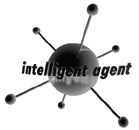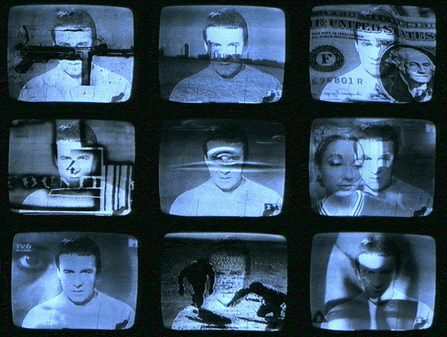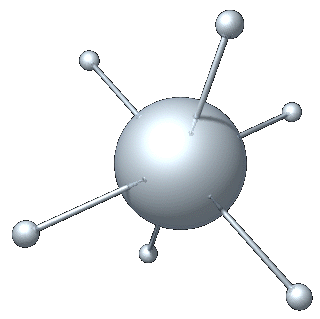
I don't believe in self-expression

 Tilman Baumgärtel spoke with Alexei Shulgin during the conference "Beauty and the East," which took place in Ljubliana in '97. TB: Before you discovered the Internet, you were exploring other art forms--would you tell us more about your earlier works? AS: Before I discovered the Net I was doing more traditional art. I started working with photography, and then it was cinematic objects and video. But it was always about the language of art, and the role of art and images in society. It was also about recycling already existing images because I think that the world is overloaded with them. We have more than enough images, and now there's the question of selection, collection and distribution. My first experiment with the Internet took place in 1994, when I set up an online gallery of Russian art photography. My motivation for doing this was political; it went against the existing practice of art curating and had to do with exclusion and inclusion. There had been a big show of Russian photography in Germany, Neue Fotokunst aus Russland [New Photo Art from Russia], at Badischer Kunstverein, Karlsruhe; Kulturhaus Osterfeld, Pforzheim; Karmeliterkloster, Frankfurt; Museum für Volk und Wirtschaft, Düsseldorf. Some very interesting projects and series of works were not included because of the obvious ignorance of the curators. TB: On the German or on the Russian side? AS: On both sides, because they were too busy playing political games. Being a photographer I was included in this show, but I thought there was something wrong with the whole concept. So I proposed to do a kind of supplement to the show on the Internet. TB: Had you ever used the Internet before? AS: No, I had just found out that there was such a medium. I knew nothing about HTML. So I set up the site, yet it didn't get included into the show because of budget cuts. But it was one of the first art photography exhibitions on the Net ever. TB: There is this famous quote by Adorno--if a symphony is broadcast over the radio it's questionable if it still is a symphony at all. Doesn't that also apply when you use the Internet as a medium for the distribution of photography? AS: Of course, it's different. But photography in its traditional sense is first an image, and then an object. The object part of photography is not that important as in painting or sculpture. So if you put photography online, it is just a little bit worse than a reproduction in a catalogue, because of the lower resolution and the smaller size of the pictures. Don't forget that this was in 1994, a time of experiments. Now I wouldn't do this anymore. I started to get more interested in this medium and in 1995 I learned HTML and got access to a server at the University of Moscow. I started a virtual institution called Moscow WorldWideWeb Art Centre. TB: Is this an actual institution or does it exist exclusively as an Internet project? AS: It's not an institution at all. It's just a group of people, nothing official. The aim of this organization has been to create a space where Russian artists could show their work. I only put works on the Net that were suitable for the Internet format. It isn't about reproductions of works. I would rather exhibit more interactive and conceptual projects online, which work very well on the Internet. I spent one year setting it up and holding workshops. And little by little I became part of the international Net art community. I attended a few conferences. The most important one was Next Five Minutes in Amsterdam in 1996, where I met some people who I'd known before through the Net, like Heath Bunting and Jodi and Vuk Cosic. TB: How did that affect your work on the Net?  AS: I became more and more aware of the possibilities and the nature of the Net. I started to get involved in a number of projects that were cooperations between people who live in different countries and are active on the Net. They were not necessarily artists. These activities were based on the idea of communication rather than representation like in more traditional art forms. In that respect, the Net works perfectly. TB: The Net art scene is very international. You seem to belong to a circle that includes a number of Western European artists. Did that bring about a change in your perception of yourself as an artist? AS: I feel much more included than before. When I was just an artist living in Moscow, whatever I did has always been labeled "Eastern," "Russian," whatever. All my work was placed in this context. That was really unfortunate, because I never felt that I did something specifically Russian. TB: Do you think that the Net has created an internationalized group of people who share common ideas and interests, even though they live in very different countries? AS: Sure. That's also why Net art escapes any kind of contextualization. The problem we have to face now is a lack of critical context. Art always takes place in some space, in a museum or whatever. Even when it's a performance, it takes place in an environment that is marked as an art space. Even if it's not an art space, it is appropriated by artists and therefore turned into a space for art. On the Net, you're not dealing with physical space. Everything happens on your computer screen, and it doesn't matter where the signals come from. That has created a lot of misunderstanding. People are getting lost because they don't know how to deal with the data they are receiving. Is it art, or not? People want to put things into context, they don't believe their own eyes.
TB: So why can't they make money with Net art? AS: Because the motivation for it isn't money--it's pure enthusiasm, which works for me. Actually, it's changing a little this year, which is marked by the growing interest of official art institutions'--such as Ars Electronica or Documenta or many others. I'm producing a web project as artist in residence in Budapest now. But there still is no real money behind it. TB: So how do you support yourself since one cannot really make money with Net art? AS: I can always go back to photography, and I can earn something if I get invited to shows. But what I don't want to do is get into programming. TB: So how do you do your sites if you're not into programming? Do you have an assistant? AS: No, I do plain HTML myself, and some very simple Java Scripts that are stolen from other sites--a widespread practice. TB: So what's the basis of your "business model" as an artist? Are you going to rely on stipends or invitations from art institutions? AS: No, I don't like to be dependent on that. If I did this, I could be very easily manipulated. What would I do if I didn't get the next residency grant? At this point I can't imagine a good model, but I don't worry because this particular time is very interesting. It's a beginning. It's the earliest stage. If you deal with technology-based art, the very first years are always the most exciting ones. Look at photography: when they invented the 35-millimeter camera there was this explosion of art photography in the late twenties and early thirties. Artists just did whatever they wanted to do with it. They didn't worry how it would fit into the art system. They were just playing around with it, experimenting with the medium, and getting really great results. The same can be said about video. Today's video art doesn't interest me at all. Artists now use it as a new tool for self-expression. But I don't believe in self-expression. I don't need to look at somebody expressing him- or herself. There is too much information out there already. I don't need more. But when this medium--video--appeared, it was really interesting to watch what artists were doing with it. The same goes for the Net: we are now in the early stage, and people are just drawn to it by their enthusiasm. TB: What's really interesting about this comparison between video art and Net art is that video art moved in two different directions: there is this very complacent and hermetic subgenre of video art now, but video has also become a very natural part of art pieces, performances and environments. 
AS: Of course, the same thing is going to happen with the Net. Artists are already using the Internet in their work in galleries. In the case of video, the only way of distributing the works was through the art system. So far, this hasn't applied to Internet art, but this year I feel that we really need somebody to take care of distribution. TB: But the Internet is distribution! AS: Yeah, but imagine everybody being online and creating webpages, it would become overwhelming. Who would search for the grains of gold in all this shit? TB: So there should be some Internet censor who decides what stays online? AS: Of course. This kind of curating and selecting can be done with very little money. I don't know what the model will look like, though. But the future of the medium doesn't interest me at all. I'm enjoying the moment, and I'm trying to get as much out of it as possible. If it gets boring I'll probably give it up and do something else. TB: I sense a lot of hostility towards the traditional art world among Net artists. It seems to me, that a lot of artists started doing things on the Net in order to find a way around the traditional art institutions. AS: For me it was a way to get around the way I was contextualized. I also got very tired of these big shows that give nothing to artists themselves. They generate some fame and success for curators, but not for the artists. When I started, there wasn't any context at all for Net art, which was really great. Of course, there was almost no audience for it either. Maybe we should create a situation where the artists are both the audience and the collaborators. I don't know how this might work because everybody is so egotistic, but there is some form of communication on the Net that at times strikes me as very strange: people are not together, but yet they are; it's not a movement, it's not real friendship, it's something in-between. TB: Some of your projects have dealt with a method of remote collaboration, Refresh for example. It is a "chain of homepages" so to speak, that appears on a viewer's computer screen without the user having to do anything. Can you tell me more about this project? AS: "Refresh" was very significant because it was an attempt to bring together very different egos and do some big thing with everybody working independently. In this sense I am very happy with it. TB: Are there people involved in this project that you have never met in person? AS: Many of them I don't know at all. I had never heard about them before. TB: "Refresh" doesn't work properly anymore. Does that matter to you? AS: No, not really. The Net itself doesn't work properly, so how could "Refresh" work? I actually thought that it would stop working much earlier. I thought it would stop when it reached ten pages. But it kept growing, and at one point it really worked with thirty pages.  The First International Form Art Competition: create your Form Art piece(s) out of form elements--no gifs or jpegs, no colors, no text! TB: Interactivity is the feature that supposedly distinguishes Net art from other art forms. What do you think are particular characteristics of Net art? AS: I don't believe in interactivity because I think it is a very simple and obvious way for manipulating people. What happens in the case of so-called interactive art is that artists propose an interactive piece and declare: "Oh, it's very democratic! Participate! Create your own world! Click this button, and you are as much the author of the piece as I am." But it is never true. There are always authors with a name and a career behind it, and they just seduce people to click buttons in their own name. I am doing a piece on this right now for a show in Budapest. The piece is called "form," and I encourage people to add to it. But I am honest. I'm not saying: send it in, and I will sign it. I will organize a competition with a cash prize, like $ 1000. I think that will stimulate people to contribute. I haven't decided yet if there will be just one prize or if I will send some money to everybody who contributes. I really want to make this an equal exchange. They work for me, and I give them money. I think it's much fairer than what many of these so-called interactive artists do. TB: Net art seems to be very self-referential to me. Why? AS: Because it exists only on the Net. If you do it as a part of a gallery installation it is different. In fact I did this with the piece I just described. I had some of it printed out on a laser printer, and put it in nice frames on the wall. It works... TB: But only Net people get it... AS: No, in fact I watched how the audience reacted at the show in Budapest, and they knew nothing about the Internet but still were able to read it very easily. It's like very primitive art. TB: For the project "Internet Gold Medal" [in collaboration with Tania Detkina and Rachel Baker] you selected peculiar websites and declared them to be works of art. You awarded them prizes in very dubious categories, for example for the "correct use of the color pink." Is this piece a comment on the blurring of the differences between high and low art on the Internet, on the fact that--since everybody can put stuff on the Net--respected "high" art from the Louvre has the same status as some amateur's work in water color? AS: I am acting as a sort of curator who browses the Web looking for unrecognized talents because many people are very timid when it comes to their work. They do interesting things and put them on the Web but they have never been part of the art system. The stuff I am selecting is like a parody of the things you can see in a gallery or museum. TB: There is some cynical humor in selecting "found art" on the Web and then combining it with "found art criticism," as you do on that site. AS: Sure, but I think you can find a lot of cynicism in the art system in general. It's even more cynical and hypocritical since it's about money and power. TB: Do you think that Net art can be co-opted by the art institutions? AS: No, that won't happen. They are trying to do it but they always fail because the Net is too complicated and never works properly. For example, it wasn't possible to include "Refresh" in a few exhibitions. It's interesting, but it lies in the nature of the Net that it doesn't work. There are a lot of shows that are trying to exhibit Net art right now but even if it is online it's always fake. You have to put your files on their server for easy access and fast connection. But if I knew that the connection were fast I would do something completely different, with large images, a lot of graphics. It's a big contradiction. 
Tilman Baumgärtel (Tilman_Baumgaertel@compuserve.com) is a free-lance writer who lives in Berlin and on the Internet. His works appear in die tageszeitung; on Telepolis, and Spiegel-Online, as well as a number of other publications. Alexei Shulgin is a Moscow-based artist, curator and photographer, working on the Internet since 1994. He is the founder of "Moscow WWWArt Centre" and inventor of "Form Art." Shulgin's projects on the Internet include: Moscow WWArt Centre Bla-bla Remedy for Information Disease WWWArt Award Turn off the TV set Form |